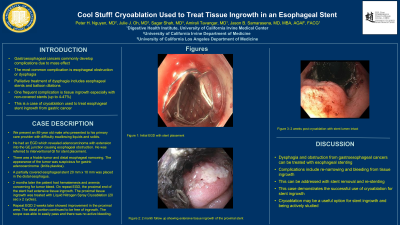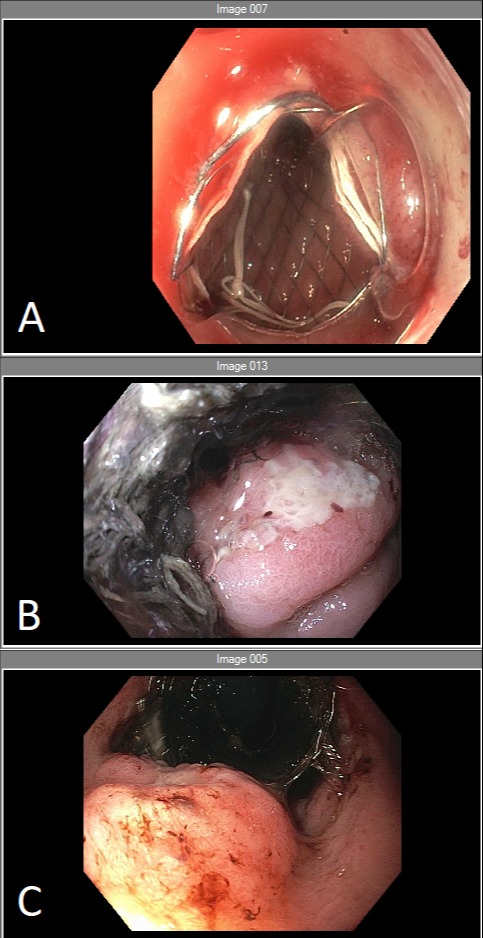Back


Poster Session C - Monday Afternoon
Category: Esophagus
C0262 - Cool Stuff! Cryoablation Used to Treat Tissue Ingrowth in an Esophageal Stent
Monday, October 24, 2022
3:00 PM – 5:00 PM ET
Location: Crown Ballroom

Has Audio

Peter H. Nguyen, MD
University of California, Irvine
Orange, CA
Presenting Author(s)
Peter H. Nguyen, MD1, Julie J. Oh, MD2, Sagar Shah, MD3, Amirali Tavangar, MD2, Jason Samarasena, MD, MBA, FACG4
1University of California, Irvine, Orange, CA; 2University of California Irvine, Orange, CA; 3UCLA, Orange, CA; 4UC Irvine, Orange, CA
Introduction: Gastroesophageal cancers commonly develop complications due to the mass effect with the most common complication being esophageal obstruction or dysphagia if not the presenting symptom. Palliative treatment of the dysphagia includes esophageal stent or dilation balloons. One of the most frequent complication of esophageal stenting is tissue ingrowth. Literature shows an incidence of 4-47% with higher incidence in non-covered stents. This is a case of cryoablation used to treat esophageal stent ingrowth from gastric cancer with proximal extension into the distal esophagus.
Case Description/Methods: An 89 year old male presented to his primary care provider with progressive difficulty swallowing solid and liquids. He was only able to eat small bits of food and drink sips. He was referred to gastroenterology (GI)for an EGD which revealed adenocarcinoma with extension into the GE junction causing the esophageal obstruction. He was referred to interventional GI for esophageal stent placement. There was a friable tumor and distal esophageal narrowing. The appearance of the tumor, edema, thickened folds, and poor distension of the stomach was suspicious for gastric adenocarcinoma (linitis plastica). A partially covered esophageal stent (20 mm x 10 cm) was placed and secured in place in the distal esophagus. 2 months later, the patient returned due to hematemesis and anemia concerning for tumor bleed. On EGD, the uncovered proximal end of the stent had extensive tissue ingrowth. There did not appear to be neoplastic tissue. The distal portion was free from ingrowth. Liquid Nitrogen Spray Cryoablation (20 sec x 2 cycles) was performed on the proximal tissue ingrowth. 2 weeks later, the patient had a repeat EGD to reassess the site. The tissue ingrowth over the proximal end of the stent improved compared to the prior EGD (Figure 1). The distal end continued to be free from ingrowth. The scope was easily able to pass through the stent as well and no active bleeding was seen.
Discussion: Dysphagia and obstruction from gastroesophageal cancers can be treated with esophageal stenting, however there may be re-narrowing or bleeding from tissue ingrowth. This could be addressed with stent removal and re-stenting; however, this case demonstrates the successful use of cryoablation for stent ingrowth. Cryoablation may be a useful option for stent ingrowth and is being actively studied currently.

Disclosures:
Peter H. Nguyen, MD1, Julie J. Oh, MD2, Sagar Shah, MD3, Amirali Tavangar, MD2, Jason Samarasena, MD, MBA, FACG4. C0262 - Cool Stuff! Cryoablation Used to Treat Tissue Ingrowth in an Esophageal Stent, ACG 2022 Annual Scientific Meeting Abstracts. Charlotte, NC: American College of Gastroenterology.
1University of California, Irvine, Orange, CA; 2University of California Irvine, Orange, CA; 3UCLA, Orange, CA; 4UC Irvine, Orange, CA
Introduction: Gastroesophageal cancers commonly develop complications due to the mass effect with the most common complication being esophageal obstruction or dysphagia if not the presenting symptom. Palliative treatment of the dysphagia includes esophageal stent or dilation balloons. One of the most frequent complication of esophageal stenting is tissue ingrowth. Literature shows an incidence of 4-47% with higher incidence in non-covered stents. This is a case of cryoablation used to treat esophageal stent ingrowth from gastric cancer with proximal extension into the distal esophagus.
Case Description/Methods: An 89 year old male presented to his primary care provider with progressive difficulty swallowing solid and liquids. He was only able to eat small bits of food and drink sips. He was referred to gastroenterology (GI)for an EGD which revealed adenocarcinoma with extension into the GE junction causing the esophageal obstruction. He was referred to interventional GI for esophageal stent placement. There was a friable tumor and distal esophageal narrowing. The appearance of the tumor, edema, thickened folds, and poor distension of the stomach was suspicious for gastric adenocarcinoma (linitis plastica). A partially covered esophageal stent (20 mm x 10 cm) was placed and secured in place in the distal esophagus. 2 months later, the patient returned due to hematemesis and anemia concerning for tumor bleed. On EGD, the uncovered proximal end of the stent had extensive tissue ingrowth. There did not appear to be neoplastic tissue. The distal portion was free from ingrowth. Liquid Nitrogen Spray Cryoablation (20 sec x 2 cycles) was performed on the proximal tissue ingrowth. 2 weeks later, the patient had a repeat EGD to reassess the site. The tissue ingrowth over the proximal end of the stent improved compared to the prior EGD (Figure 1). The distal end continued to be free from ingrowth. The scope was easily able to pass through the stent as well and no active bleeding was seen.
Discussion: Dysphagia and obstruction from gastroesophageal cancers can be treated with esophageal stenting, however there may be re-narrowing or bleeding from tissue ingrowth. This could be addressed with stent removal and re-stenting; however, this case demonstrates the successful use of cryoablation for stent ingrowth. Cryoablation may be a useful option for stent ingrowth and is being actively studied currently.

Figure: Figure 1. A) Stent initially placed. B) Stent with tissue ingrowth 2 months later. C) Stent with the lumen intact 2 weeks later.
Disclosures:
Peter Nguyen indicated no relevant financial relationships.
Julie Oh indicated no relevant financial relationships.
Sagar Shah indicated no relevant financial relationships.
Amirali Tavangar indicated no relevant financial relationships.
Jason Samarasena: Conmed – Consultant. Docbot – Stock Options. Mauna Kea – Consultant. Olympus – Consultant. Ovesco – Consultant. Steris – Consultant.
Peter H. Nguyen, MD1, Julie J. Oh, MD2, Sagar Shah, MD3, Amirali Tavangar, MD2, Jason Samarasena, MD, MBA, FACG4. C0262 - Cool Stuff! Cryoablation Used to Treat Tissue Ingrowth in an Esophageal Stent, ACG 2022 Annual Scientific Meeting Abstracts. Charlotte, NC: American College of Gastroenterology.
